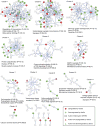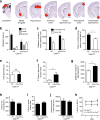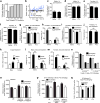Autism gene Ube3a and seizures impair sociability by repressing VTA Cbln1
- PMID: 28297715
- PMCID: PMC5364052
- DOI: 10.1038/nature21678
Autism gene Ube3a and seizures impair sociability by repressing VTA Cbln1
Abstract
Maternally inherited 15q11-13 chromosomal triplications cause a frequent and highly penetrant type of autism linked to increased gene dosages of UBE3A, which encodes a ubiquitin ligase with transcriptional co-regulatory functions. Here, using in vivo mouse genetics, we show that increasing UBE3A in the nucleus downregulates the glutamatergic synapse organizer Cbln1, which is needed for sociability in mice. Epileptic seizures also repress Cbln1 and are found to expose sociability impairments in mice with asymptomatic increases in UBE3A. This Ube3a-seizure synergy maps to glutamate neurons of the midbrain ventral tegmental area (VTA), where Cbln1 deletions impair sociability and weaken glutamatergic transmission. We provide preclinical evidence that viral-vector-based chemogenetic activation of, or restoration of Cbln1 in, VTA glutamatergic neurons reverses the sociability deficits induced by Ube3a and/or seizures. Our results suggest that gene and seizure interactions in VTA glutamatergic neurons impair sociability by downregulating Cbln1, a key node in the expanding protein interaction network of autism genes.
Conflict of interest statement
Figures















Similar articles
-
Hypersociability in the Angelman syndrome mouse model.Exp Neurol. 2017 Jul;293:137-143. doi: 10.1016/j.expneurol.2017.04.002. Epub 2017 Apr 11. Exp Neurol. 2017. PMID: 28411125 Free PMC article.
-
Increased gene dosage of Ube3a results in autism traits and decreased glutamate synaptic transmission in mice.Sci Transl Med. 2011 Oct 5;3(103):103ra97. doi: 10.1126/scitranslmed.3002627. Sci Transl Med. 2011. PMID: 21974935 Free PMC article.
-
UBE3A and transsynaptic complex NRXN1-CBLN1-GluD1 in a hypothalamic VMHvl-arcuate feedback circuit regulates aggression.bioRxiv [Preprint]. 2023 Mar 1:2023.02.28.530462. doi: 10.1101/2023.02.28.530462. bioRxiv. 2023. PMID: 36909588 Free PMC article. Preprint.
-
Cbln1 and its family proteins in synapse formation and maintenance.Curr Opin Neurobiol. 2011 Apr;21(2):215-20. doi: 10.1016/j.conb.2011.01.010. Epub 2011 Feb 20. Curr Opin Neurobiol. 2011. PMID: 21342763 Review.
-
Epigenetic regulation of UBE3A and roles in human neurodevelopmental disorders.Epigenomics. 2015 Oct;7(7):1213-28. doi: 10.2217/epi.15.70. Epub 2015 Nov 20. Epigenomics. 2015. PMID: 26585570 Free PMC article. Review.
Cited by
-
Tourette Syndrome Risk Genes Regulate Mitochondrial Dynamics, Structure, and Function.Front Psychiatry. 2021 Mar 10;11:556803. doi: 10.3389/fpsyt.2020.556803. eCollection 2020. Front Psychiatry. 2021. PMID: 33776808 Free PMC article.
-
Subcellular organization of UBE3A in human cerebral cortex.Mol Autism. 2018 Oct 19;9:54. doi: 10.1186/s13229-018-0238-0. eCollection 2018. Mol Autism. 2018. PMID: 30364390 Free PMC article.
-
A Systematic Review of Brainstem Contributions to Autism Spectrum Disorder.Front Integr Neurosci. 2021 Nov 1;15:760116. doi: 10.3389/fnint.2021.760116. eCollection 2021. Front Integr Neurosci. 2021. PMID: 34790102 Free PMC article.
-
Excessive UBE3A dosage impairs retinoic acid signaling and synaptic plasticity in autism spectrum disorders.Cell Res. 2018 Jan;28(1):48-68. doi: 10.1038/cr.2017.132. Epub 2017 Oct 27. Cell Res. 2018. PMID: 29076503 Free PMC article.
-
Optimized isolation of enzymatically active ubiquitin E3 ligase E6AP/UBE3A from mammalian cells.Protein Expr Purif. 2025 Apr;228:106661. doi: 10.1016/j.pep.2025.106661. Epub 2025 Jan 9. Protein Expr Purif. 2025. PMID: 39798888
References
-
- Jiang YH, et al. Mutation of the Angelman ubiquitin ligase in mice causes increased cytoplasmic p53 and deficits of contextual learning and long-term potentiation. Neuron. 1998;21:799–811. - PubMed
Publication types
MeSH terms
Substances
Grants and funding
LinkOut - more resources
Full Text Sources
Other Literature Sources
Medical
Molecular Biology Databases
Research Materials

